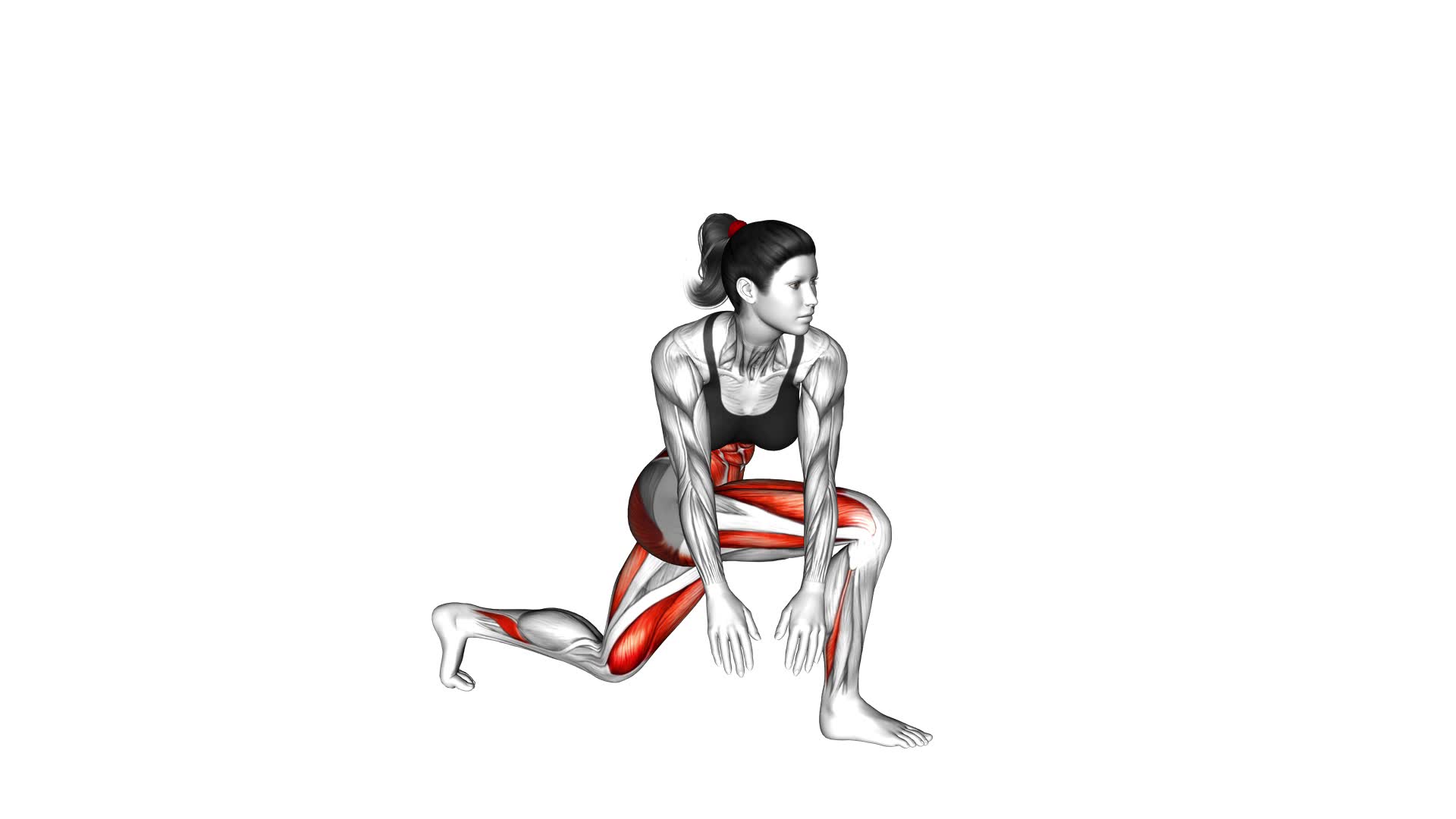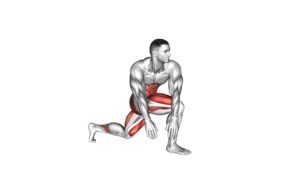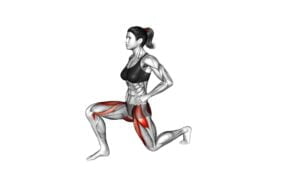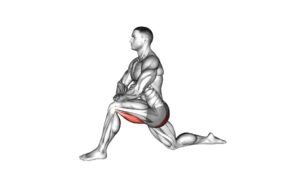Crossover Kneeling Hip Flexor Stretch (female) – Video Exercise Guide & Tips

Are you looking for a new exercise to target your hip flexors? Look no further!
Watch This Exercise Video
In this video exercise guide, we will walk you through the Crossover Kneeling Hip Flexor Stretch specifically designed for females.
With step-by-step instructions and helpful tips, you'll learn how to properly perform this stretch to improve flexibility and prevent muscle imbalances.
Get ready to feel the burn and take your fitness routine to the next level!
Key Takeaways
- The Crossover Kneeling Hip Flexor Stretch improves flexibility and range of motion in the hips.
- Proper form and alignment, focusing on hip positioning and engaging core muscles, is important for females performing this stretch.
- Maintaining proper hip positioning and alignment can enhance athletic performance and reduce muscle imbalances and joint pain.
- Engaging core muscles, practicing stability exercises, and maintaining proper alignment can improve balance and stability during the stretch.
Benefits of the Crossover Kneeling Hip Flexor Stretch
To maximize the benefits of the Crossover Kneeling Hip Flexor Stretch, perform the exercise for at least 30 seconds on each side. This stretch is highly effective in improving flexibility and relieving lower back pain. By targeting the hip flexor muscles, which are responsible for flexing the hip joint and stabilizing the pelvis, this stretch can help increase the range of motion in the hips and alleviate tension in the lower back.
When you perform the Crossover Kneeling Hip Flexor Stretch, you're stretching the muscles at the front of your hips, including the psoas and iliacus muscles. These muscles can become tight and shortened due to prolonged sitting or activities that require repetitive hip flexion, leading to limited mobility and discomfort in the lower back. By regularly incorporating this stretch into your routine, you can help lengthen and relax these muscles, promoting improved flexibility and reducing the strain on your lower back.
Now that you understand the benefits of the Crossover Kneeling Hip Flexor Stretch, let's move on to discussing proper form and alignment for females.
Proper Form and Alignment for Females
To ensure proper form and alignment during the Crossover Kneeling Hip Flexor Stretch, there are a few key points to keep in mind.
First, focus on hip positioning for females, as their anatomy may require slight adjustments compared to males.
Second, incorporate balance and stability techniques, such as engaging your core and maintaining a neutral spine, to maximize the effectiveness of the stretch.
Hip Positioning for Females
Maintain proper hip positioning to ensure proper form and alignment during exercises. Common mistakes in hip positioning for females can lead to improper alignment, which increases the risk of injury and reduces the effectiveness of the exercise.
It's important for female athletes to focus on hip flexibility as it plays a crucial role in their performance and overall fitness. Adequate hip flexibility allows for a greater range of motion, which improves athletic performance and reduces the risk of muscle imbalances and joint pain.
Proper hip positioning also helps to engage the correct muscles and target the intended muscle groups during exercises. By maintaining proper hip positioning, you can maximize the benefits of your workout and improve your overall balance and stability.
Transitioning into the subsequent section about 'balance and stability techniques', let's explore some strategies to enhance your balance and stability during exercises.
Balance and Stability Techniques
Enhance your balance and stability during exercises by focusing on proper form and alignment for females.
Balance techniques are essential for maintaining stability and preventing injuries while performing various exercises. One important aspect of balance is maintaining a strong core, which helps to stabilize the body during movements. Engaging your core muscles, such as the abdominals and lower back, can greatly improve your balance.
Another effective balance technique is practicing exercises that challenge your stability, such as standing on one leg or using a balance board. These exercises help to strengthen the muscles responsible for maintaining balance.
Additionally, maintaining proper alignment, such as keeping your spine neutral and your knees aligned with your toes, is crucial for stability during exercises.
Step-by-Step Guide to Performing the Stretch
Perform the stretch by positioning yourself in a kneeling position. Start by kneeling on a soft surface with one knee on the ground and the other knee bent at a 90-degree angle in front of you. Your front foot should be flat on the ground, with the knee directly above the ankle. Keep your back straight and engage your core muscles to maintain stability throughout the stretch.
To begin the crossover kneeling hip flexor stretch, bring your back foot up and place it on the ground behind you, with the toes pointing slightly outward. Slowly shift your weight forward, keeping your body upright, until you feel a gentle stretch in the front of your hip and thigh. Hold this position for 20 to 30 seconds, focusing on deep, controlled breathing.
This stretch provides several benefits, including increased flexibility and range of motion in the hip flexor muscles. It can also help alleviate tightness and discomfort in the hip area.
To maximize the effectiveness of this stretch, it's important to avoid common mistakes such as arching your back, leaning too far forward, or allowing the front knee to go past the toes. Remember to listen to your body and only stretch to a point of mild tension, not pain.
Modifications and Variations for Different Fitness Levels
To modify the crossover kneeling hip flexor stretch for different fitness levels, you can adjust the depth of the stretch and the amount of weight shifted forward. Here are four modifications and progressions you can try:
- Decrease the depth of the stretch: If you're a beginner or have limited flexibility, you can start by performing a shallow version of the stretch. Instead of crossing your leg over your body, keep it closer to your body and focus on feeling a gentle stretch in your hip flexors. As you become more comfortable, you can gradually increase the depth of the stretch.
- Shift less weight forward: To make the stretch easier, you can shift less weight forward onto your front leg. Instead of leaning your torso forward, keep it more upright. This will reduce the intensity of the stretch while still targeting your hip flexors.
- Increase the depth of the stretch: For those who are more advanced or have good flexibility, you can deepen the stretch by crossing your leg further over your body. This will increase the stretch in your hip flexors and challenge your flexibility.
- Shift more weight forward: To make the stretch more challenging, you can shift more weight forward onto your front leg. Lean your torso further forward, allowing for a deeper stretch in your hip flexors. Be mindful of maintaining proper form and not overstretching.
Remember to listen to your body and only progress to more difficult variations when you feel ready. These modifications and progressions can help you tailor the crossover kneeling hip flexor stretch to your fitness level and goals.
Tips for Getting the Most Out of Your Stretch
To get the most out of your stretch, it's important to focus on proper form techniques.
Make sure you maintain a straight posture and engage your core muscles.
Additionally, remember to breathe deeply and relax your body to allow for a deeper stretch.
Proper Form Techniques
Get the most out of your hip flexor stretch by focusing on proper form techniques. Here are four tips to help you maximize the benefits of your stretch:
- Maintain proper alignment: Keep your back straight and your hips square throughout the exercise. Avoid arching your back or leaning forward.
- Engage your core: Activate your abdominal muscles to stabilize your body and enhance the stretch. This will also help prevent strain on your lower back.
- Gradually increase the stretch: Start with a gentle stretch and gradually deepen it over time. Avoid forcing your body into a position that feels uncomfortable or painful.
- Breathe deeply and relax: Take slow, deep breaths throughout the stretch to promote relaxation and release tension in your muscles.
Breathing and Relaxation
Breathe deeply and relax to enhance the benefits of your hip flexor stretch. Proper breathing techniques and relaxation exercises can greatly improve your stretching experience.
As you perform the crossover kneeling hip flexor stretch, focus on taking slow, deep breaths. Inhale deeply through your nose, expanding your belly, and exhale slowly through your mouth, releasing any tension in your body. Deep breathing helps to oxygenate your muscles, allowing them to relax and stretch more effectively.
Additionally, incorporating relaxation exercises such as progressive muscle relaxation or mindfulness meditation can further enhance your stretching session. These techniques promote a state of calmness and reduce stress, allowing you to fully engage with your stretch and increase its effectiveness.
Remember to prioritize your breathing and relaxation to optimize the benefits of your hip flexor stretch.
Precautions and Safety Measures to Consider
Ensure that you maintain a stable and balanced position throughout the Crossover Kneeling Hip Flexor Stretch to prevent any potential strain or injury. To perform this stretch safely, consider the following precautions and safety measures:
- Start with a warm-up: Before attempting any stretching exercises, it's important to warm up your muscles. Engage in light aerobic activity or dynamic stretches to increase blood flow and prepare your body for the stretch.
- Gradually increase the stretch: Begin with a gentle stretch and gradually increase the intensity. Avoid pushing yourself too far too quickly, as this can lead to muscle strains or other injuries. Listen to your body and only stretch to a comfortable level.
- Modify the stretch if needed: If you find the traditional Crossover Kneeling Hip Flexor Stretch challenging or uncomfortable, there are modifications you can try. For example, you can place a pillow or yoga block under your back knee for added support and to decrease the intensity of the stretch.
- Consult a professional: If you have any pre-existing medical conditions or concerns about performing this stretch, it's always best to consult with a healthcare professional or a certified fitness instructor. They can provide guidance and ensure that you're performing the stretch safely and effectively.
Frequently Asked Questions
Can Men Also Perform the Crossover Kneeling Hip Flexor Stretch?
Yes, men can also perform the crossover kneeling hip flexor stretch.
It's important for men to work on their flexibility, and hip flexor stretches can provide numerous benefits.
By incorporating this stretch into your routine, you can improve hip mobility, increase flexibility in the lower body, and reduce the risk of injury.
Is It Necessary to Warm up Before Doing This Stretch?
Before performing any stretch, it's important to warm up your muscles properly. Warming up increases blood flow and prepares your body for the demands of stretching. It helps prevent injuries and improves flexibility.
Incorporating stretching into your workout routine has many benefits. It increases your range of motion, enhances muscle flexibility, and reduces muscle soreness.
How Often Should I Perform the Crossover Kneeling Hip Flexor Stretch?
To get the most benefit from the crossover kneeling hip flexor stretch, it's important to know how often to perform it. Consistency is key! Aim to do this stretch at least 2-3 times a week.
However, if you're a beginner, it's essential to modify the stretch to suit your level. You can start by reducing the range of motion or using a support like a yoga block.
Can This Stretch Help With Lower Back Pain?
Yes, the crossover kneeling hip flexor stretch can help with lower back pain. Incorporating stretching into your daily routine has numerous benefits, including improving flexibility and relieving muscle tension.
To perform this stretch effectively, start by kneeling on one knee with the opposite foot positioned in front. Then, lean forward and rotate your torso towards the front leg, feeling a stretch in the hip and lower back.
Hold for 30 seconds and repeat on the other side.
Are There Any Alternative Stretches That Target the Same Muscle Group?
There are alternative stretches that target the same muscle group as the Crossover Kneeling Hip Flexor Stretch.
One option is the Standing Hip Flexor Stretch, where you stand upright and bring one foot up towards your glutes, holding onto your ankle.
Another option is the Lunge Stretch, where you step forward into a lunge position and press your hips forward.
Both of these stretches can help improve flexibility and reduce muscle tightness in the hip flexors, providing similar benefits to the Crossover Kneeling Hip Flexor Stretch.
Conclusion
In conclusion, the crossover kneeling hip flexor stretch is an effective exercise for females to stretch and strengthen their hip flexor muscles. By following proper form and alignment, using modifications and variations as needed, and implementing helpful tips, individuals can maximize the benefits of this stretch.
It's important to consider precautions and safety measures to prevent injury and ensure a safe workout. Incorporating this stretch into your fitness routine can improve flexibility and overall hip mobility.

Author
Years ago, the spark of my life’s passion ignited in my mind the moment I stepped into the local gym for the first time. The inaugural bead of perspiration, the initial endeavor, the very first surge of endorphins, and a sense of pride that washed over me post-workout marked the beginning of my deep-seated interest in strength sports, fitness, and sports nutrition. This very curiosity blossomed rapidly into a profound fascination, propelling me to earn a Master’s degree in Physical Education from the Academy of Physical Education in Krakow, followed by a Sports Manager diploma from the Jagiellonian University. My journey of growth led me to gain more specialized qualifications, such as being a certified personal trainer with a focus on sports dietetics, a lifeguard, and an instructor for wellness and corrective gymnastics. Theoretical knowledge paired seamlessly with practical experience, reinforcing my belief that the transformation of individuals under my guidance was also a reflection of my personal growth. This belief holds true even today. Each day, I strive to push the boundaries and explore new realms. These realms gently elevate me to greater heights. The unique combination of passion for my field and the continuous quest for growth fuels my drive to break new ground.







